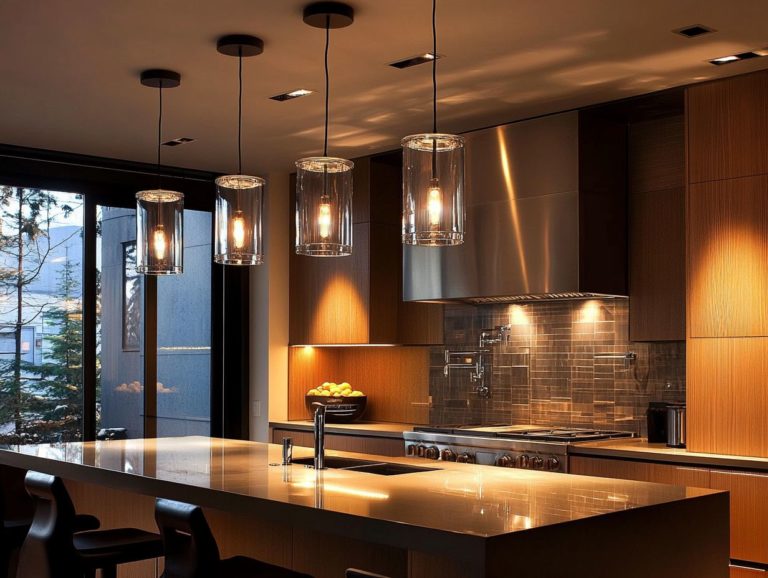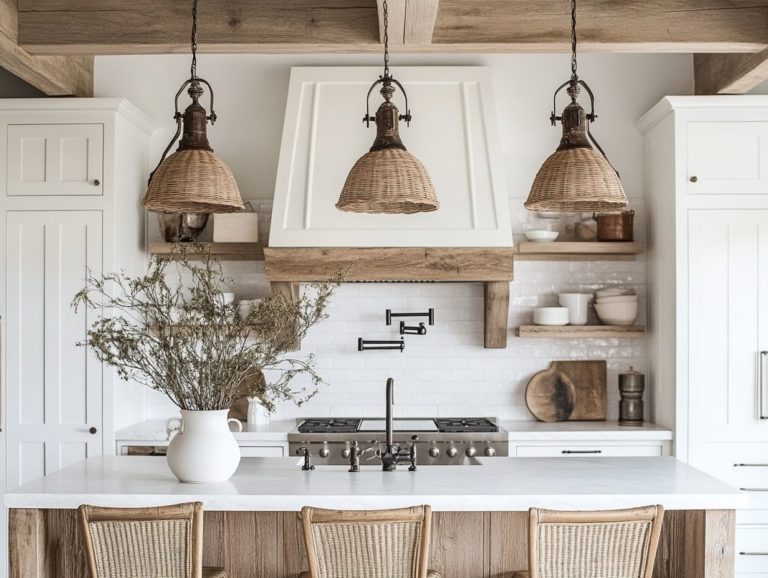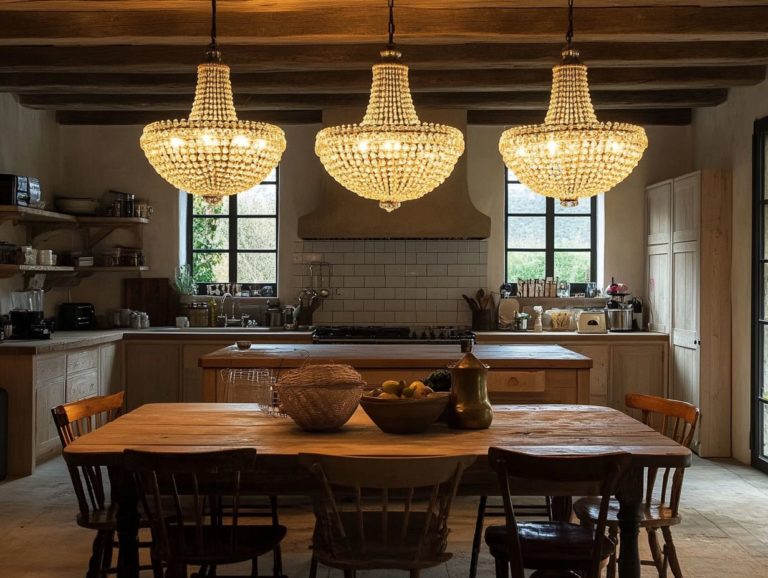LED vs. Incandescent: Which is Better for Kitchens?
Selecting the ideal lighting for your kitchen can profoundly influence both its practicality and atmosphere.
Among the myriad options, two prominent contenders emerge: LED and incandescent lighting. Each offers distinct advantages. LED lights are known for their energy efficiency and cost savings. In contrast, incandescent bulbs provide a warm glow and excellent color rendering.
Discover the benefits of each lighting type and find the perfect fit for your kitchen!
Contents
Key Takeaways on Kitchen Lighting Options:

LED lighting is the better choice for kitchens due to its energy efficiency and cost savings. While incandescent lighting provides warmth and excellent color rendering, LED lights last longer and are more durable. When deciding between LED and incandescent lighting for your kitchen, consider factors such as the size and layout of your space, as well as your personal preferences.
Benefits of LED Lighting in Kitchens
LED lighting brings a wealth of advantages to your kitchen, enhancing both its appearance and functionality.
These energy-efficient bulbs significantly reduce energy consumption compared to traditional incandescent and compact fluorescent lights (CFLs), resulting in substantial savings over time.
LED lights have an impressive lifespan, making them a durable choice for kitchen illumination that works well with modern smart home technologies.
Energy Efficiency and Cost Savings

One of the most significant advantages of LED lighting is its outstanding energy efficiency, which leads to considerable cost savings.
When compared to traditional incandescent bulbs, which waste up to 90% of their energy as heat, or compact fluorescent lights (CFLs) that fall short in both lifespan and energy efficiency, the choice becomes clear.
LED lights consume up to 80% less energy and last over 25,000 hours. With such impressive longevity, you’ll rarely need replacements, saving you time and money.
These savings can accumulate, allowing you to allocate more funds toward clean energy initiatives and sustainable practices in your community. By investing in LED lighting, you not only enjoy financial benefits but also play a vital role in reducing carbon footprints and promoting environmental responsibility.
Longer Lifespan and Durability
LED lights are celebrated for their impressive lifespan and durability, far surpassing traditional lighting options. This makes them an excellent choice for various fixtures in your kitchen.
Typically, LED bulbs last up to 25,000 hours, while incandescent bulbs only last about 1,000 hours, and compact fluorescent lights (CFLs) last around 10,000 hours. This longevity means you’ll replace bulbs much less frequently, which reduces maintenance costs and saves you valuable time.
Plus, you can enjoy consistent, high-quality illumination without the flickering or dimming common in older technologies. This enhanced stability in lighting fosters a more enjoyable and functional atmosphere in your kitchen, solidifying LED as the superior choice for your home.
Benefits of Incandescent Lighting in Kitchens

Incandescent lighting offers unique advantages that can enhance the ambiance of your kitchen, mainly due to its warm glow and excellent color rendering capabilities.
This lighting creates an inviting atmosphere, making it a perfect choice for kitchens where aesthetics play a crucial role.
Additionally, the relatively low initial cost of incandescent bulbs makes them an accessible option for homeowners looking to improve their kitchen lighting without a hefty financial commitment.
Warmth and Color Rendering
The warmth of incandescent bulbs is often your go-to choice for crafting an inviting kitchen atmosphere while delivering exceptional color rendering. This quality is especially advantageous for showing off the vibrant colors of your kitchen materials and finishes.
Unlike cooler, artificial lighting options, incandescent bulbs offer a color temperature that closely mimics natural sunlight. This makes it simple to spot those subtle color variations. Your countertops, cabinetry, and backsplash elements will shine in their true colors.
By incorporating incandescent undercabinet lighting, you can significantly enhance task areas, ensuring clarity while you cook. This combination makes your kitchen feel both lively and welcoming.
Low Upfront Cost

One of the most enticing aspects of incandescent lighting is its low upfront cost, making it an appealing choice for homeowners eager to brighten their kitchens without breaking the bank.
However, while that initial investment may seem attractive, it’s crucial to factor in the long-term energy costs associated with their use. Incandescent bulbs use more electricity than LEDs, which are celebrated for their energy efficiency and impressive lifespan.
This difference can add up significantly over time, potentially affecting your overall budget for kitchen renovations. As a homeowner, you’ll want to carefully weigh the immediate savings of opting for incandescent bulbs against the likelihood of higher utility bills in the future.
It’s a pivotal decision point you’ll encounter during the planning stages of your remodel.
Factors to Consider When Choosing Lighting for Kitchens
When choosing lighting for your kitchen, there are several essential factors to consider for a truly effective and visually appealing result.
Think about the size and layout of the space, along with your personal preferences for brightness and ambiance. These elements will guide you in creating a kitchen that is both functional and inviting.
Size and Layout of Kitchen
The size and layout of your kitchen are important for deciding the most suitable lighting solutions for the space.
In larger kitchens, you may find that a variety of fixtures mix different lights effectively, while in smaller kitchens, fewer, strategically placed sources can maximize brightness without overwhelming the area.
It’s essential to strike a balance between ambient, task, and accent lighting to cultivate an inviting yet functional atmosphere. Ambient lighting serves as the foundation for overall visibility, ensuring that your kitchen feels warm and welcoming. Task lighting is your ally in directing attention to specific areas, like countertops or cooking zones, providing you with the clarity needed for cooking tasks.
Meanwhile, accent lighting can be your secret weapon to highlight architectural features or artwork, adding character to your kitchen.
Personal Preferences and Needs
Your personal preferences and needs play a pivotal role in choosing the right lighting for your kitchen, shaping both the atmosphere and functionality of the space.
For example, you might prefer a bright, white light that energizes the kitchen for all those culinary adventures, while someone else may gravitate toward a warm yellow hue that invites cozy family gatherings.
Different color temperatures can set various moods, and the selection of fixtures can either enhance or diminish these effects. It’s essential to choose lighting that harmonizes with your overall kitchen design.
The right fixtures can beautifully complement cabinetry, countertops, and decor, creating a cohesive aesthetic. In the end, your satisfaction with the kitchen hinges on how well these elements come together to fulfill your specific needs.
Wattage Comparison Between Different Bulbs
Understanding the wattage comparison among different types of bulbs—incandescent, CFL, and LED—is crucial for optimizing your energy consumption and getting the right amount of light in your kitchen.
This comparison is key when selecting the best lighting solutions for cooking, meal prep, and entertaining. Incandescent bulbs provide an inviting warm glow, but they consume far more wattage than LEDs. LEDs can deliver the same brightness with significantly lower energy usage.
By examining wattage alongside lumens, which measure how bright a bulb is, you can make informed choices that will brighten your kitchen effectively while contributing to energy savings.
Choosing energy-efficient bulbs tailored to your space’s specific needs will transform your kitchen into a bright and inviting space!
Frequently Asked Questions
What are the main differences between LED and incandescent lighting?
LED lights use a semiconductor to produce light, while incandescent lights use a filament. LED lights are more energy-efficient, have a longer lifespan, and produce less heat compared to incandescent lights.
Is LED or incandescent lighting better for kitchens in terms of energy efficiency?
LED lighting is significantly more energy-efficient than incandescent lighting. LED lights consume about 75-80% less energy than incandescent lights, making them the better choice for kitchens.
Which type of lighting is better for creating a brighter kitchen?
LED lights are generally better for creating a brighter kitchen. They emit a brighter, more focused light compared to the warm and dimmer light produced by incandescent lights.
Do LED lights or incandescent lights produce less heat?
LED lights produce significantly less heat than incandescent lights. This makes LED lights a safer option for kitchens, reducing the risk of fire hazards and helping to keep the kitchen cooler.
In terms of cost, which type of lighting is better for kitchens?
Initially, incandescent lights may be cheaper to purchase than LED lights. However, in the long run, LED lights are more cost-effective due to their longer lifespan and lower energy consumption. Therefore, LED lights are the better option for kitchens in terms of cost.
Can LED lights or incandescent lights be dimmed in a kitchen setting?
Both LED and incandescent lights can be dimmed in a kitchen setting. However, LEDs are more suitable for dimming as they maintain their color temperature and do not flicker, unlike incandescent lights.





